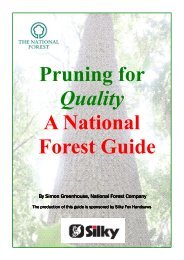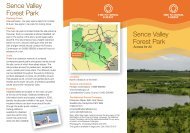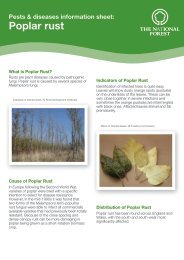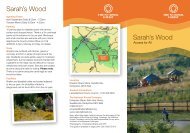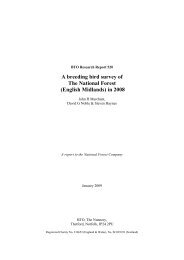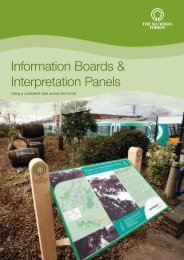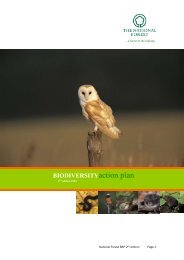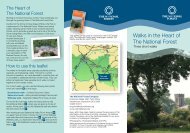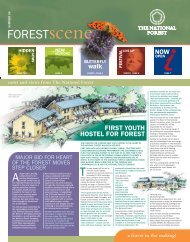Annual Report 2007-2008 - The National Forest Company
Annual Report 2007-2008 - The National Forest Company
Annual Report 2007-2008 - The National Forest Company
Create successful ePaper yourself
Turn your PDF publications into a flip-book with our unique Google optimized e-Paper software.
<strong>Annual</strong> <strong>Report</strong><strong>2007</strong>-<strong>2008</strong>
<strong>The</strong> <strong>National</strong> <strong>Forest</strong> is a new, woodedlandscape for the nation across 200 squaremiles of central England.Contents<strong>The</strong> <strong>National</strong> <strong>Forest</strong> <strong>Company</strong>was established by Government inApril 1995. <strong>The</strong> <strong>Company</strong> is limitedby guarantee (Registered number2991970) and sponsored by theDepartment for Environment,Food and Rural Affairs (Defra).Nick Barnes and Emma Flatt livein the <strong>Forest</strong> area and establishedNative <strong>Forest</strong>ry in 2005. Services includeforestry consultancy and contracting andwoodland ecology.<strong>The</strong> <strong>National</strong> <strong>Forest</strong> <strong>Company</strong>:• Attracts and uses resources for ambitious, sensitiveand imaginative <strong>Forest</strong> creation.• Provides the setting for new businesses, recreation,tourism and an improved quality of life.• Enhances wildlife and biodiversity.<strong>The</strong> <strong>National</strong> <strong>Forest</strong> <strong>Company</strong> develops workingpartnerships with landowners, businesses, public, privateand voluntary organisations and local communities to fulfilthe shared vision for the <strong>Forest</strong>. It promotes the widestpossible participation in and enjoyment of the <strong>Forest</strong>.As the <strong>Forest</strong> matures, the <strong>Company</strong> promotes at international,national and local levels, the experience and knowledgeemerging from this inspiring and ambitious project.04 Chair’s Message06 Chief Executive’s Review of the Year16 Growing Achievements18 Board of Directors19 <strong>Report</strong> of the Directors21 Remuneration <strong>Report</strong>22 Statement of the Directors’ Responsibilities23 Statement on Internal Control25 Auditors’ <strong>Report</strong>26 Financial Statements28 Notes on Financial Statements35 Five Year Review of Performance“ We were involved in the WoodlandEconomy Business Support (WEBS)programme and received businessguidance and grant funding whichhelped us to get established.We are dedicated to providingexcellent value services and our focusis on the promotion and conservationof native plants which we are verypassionate about.”Burton upon TrentDerbyBirminghamNottinghamLeicesterAll portrait photographs used in this reportwere taken by Sian Cox and Craig Thompsonas part of a project linked with their studiesat Burton College for a Foundation Degree inDigital Media Production.All other photographs taken by ChristopherBeech except where stated.SwadlincoteAshby de la ZouchCoalvilleTop: <strong>The</strong> Woodland Trust’s Willesley Wood, oneof the first sites planted in <strong>The</strong> <strong>National</strong> <strong>Forest</strong>.Bottom: Tempe Farm, near Measham,a successful 2006 Tender Scheme application.Photo: Darren Cresswell02 00 03
Chair’s MessageAnd the new Changing LandscapesScheme, launched in June <strong>2008</strong>, providesone of the most generous and widerangingincentive schemes in the country.to continue to develop and also to protectand look after the green asset we havecreated – and make a national contributionto meeting the challenge of climate change.12Dinah NicholsChairIt was the Greek sage Seneca who said“<strong>The</strong> good things which belong to prosperityare to be wished, but the good things thatbelong to adversity are to be admired”.At the beginning of this exceptional yearwe faced the prospect of a period withoutour main forest creation mechanism;an in-year cut in our Government grant;rising commodity and land prices; andconsequently a much reduced targetfor planting new woodland. For a briefmoment there was a question in the air -was this magnificent but only half-finishedproject about to lose its momentum?It certainly was not! Adversity stimulatedinventiveness and innovation, and akeen determination to find new ways ofprogressing our long-term strategy. By theend of the year we had developed somenew grant schemes for small scale planting,launched an ambitious urban forestryprogramme, gained European approvalfor a brand new successor to the TenderScheme and acquired a large strategicblock of land to create a new countrypark in the Heart of the <strong>Forest</strong>. We haveforged new partnerships and strengthenedexisting ones. So it was eventually asuccessful year, with much to admire.Although we fell short of the forest creationtarget, our new mechanisms now providea sound basis for the future. Landownerinterest in small scale schemes is high.<strong>The</strong> urban programme has already engagedcommunities, delivered new sites and“greened” some industrial estates.In addition to woodland it can supportother habitat creation and conservation,access, footpaths and signage - exactlythe mosaic of landscapes which is theessence of <strong>The</strong> <strong>National</strong> <strong>Forest</strong>.<strong>The</strong> <strong>Company</strong> was able to provide fundingfor a wide range of partnership projects toenhance the quality and variety of visitors’experience of <strong>The</strong> <strong>National</strong> <strong>Forest</strong>. Notablewere the Visitor Infrastructure Project whichis improving accessibility and signage atkey <strong>Forest</strong> gateways; funding for a majornew multipurpose trail in the Heart of the<strong>Forest</strong>; and grants towards many communityfestivals, exhibitions and educational visits.This in turn levered in over £1.2 million fromexternal public and private sources - thehighest figure ever, and a recognition by ourmany partners of their commitment to the<strong>Forest</strong>, for which we are enormously grateful.<strong>The</strong> <strong>National</strong> <strong>Forest</strong>’s guiding principle hasalways been the creation of a multipurposeforest, stimulating economic and socialbenefits as an integral part of majorlandscape improvement. It was thereforea source of great pride for the <strong>Company</strong>to be awarded the inaugural SustainableDevelopment UK Award, based on ourpublication ‘<strong>The</strong> <strong>National</strong> <strong>Forest</strong>: anexemplar of sustainable development’ andthe practical example of the transformationof the Ashby Woulds. We will continue ourrole as a national exemplar in <strong>2008</strong>/09by promoting the <strong>Forest</strong> as a case studyboth of the principles of the EuropeanLandscape Convention, and of bestpractice in dealing with climate change.It was indeed a year of challenge andchange: and next year promises to be sotoo. As I write, the consultation is underwayfor the mid-point review of our 2004 – 2014strategy. <strong>The</strong> fundamentals of the overallambition for the <strong>Forest</strong> remain unchangedbut we want to take stock of questions suchas the rate and focus of planting and howto maintain quality as the <strong>Forest</strong> expands.<strong>The</strong> very success of the <strong>Forest</strong> area bringsnew issues to address, centred around howWe aim to have a clear implementationplan for progressing the <strong>Forest</strong> to 2014and beyond, with renewed commitmentsfrom our partners, by Spring 2009.I am delighted to report that the <strong>National</strong><strong>Forest</strong> <strong>Company</strong>’s budget in the newspending period is sound and secure.I thank the Department for Environment,Food and Rural Affairs for its support andintelligent interest in the future of the <strong>Forest</strong>.Finally I must warmly thank my fellowBoard members for their commitment andsupport. I know they join me in congratulatingevery one of the <strong>Company</strong>’s small buthighly professional staff, without whosecommitment and amazing ability to multitasknone of the year’s achievements wouldhave been possible. It is a privilege to havebeen reappointed as Chair for a further term,and I look forward to another exciting year.Dinah NicholsChair3 5 64Photo: Patrick White, Apollo Photographers1: <strong>The</strong> Armed Forces Memorial at the <strong>National</strong>Memorial Arboretum, Alrewas, dedicated in thepresence of HM <strong>The</strong> Queen in October <strong>2007</strong>.2 & 3: Active leisure at Rosliston <strong>Forest</strong>ry Centre- a group of Asian men enjoy regular ‘HeathWalks’ whilst the centre proves popular withcyclists.4 & 5: Malcolm Wicks, Minister of State forEnergy presents the SD UK Award to KeithMaybury, Chair of the Ashby Woulds Forumand the NFC Chair. <strong>The</strong> award was made inrecognition of the transformation of the AshbyWoulds which includes Donington Lake, AlbertVillage (pictured).6: <strong>The</strong> purple orchid which is flourishing atHicks Lodge, a restored opencast coal site.0400 05
Chief Executive’s Review of the Year.Innovation, persistence and achievementin a challenging year.Sophie ChurchillChief Executive<strong>The</strong> context for <strong>2007</strong>/08In my introduction to last year’s annualreport, I expressed confidence in theundiminished support and involvement ofa great many organisations and individualswho continue to take forward this uniquelyambitious long term project. I also, however,commented on the challenge of predictinglong term planting rates. As the Chair’sintroduction shows, <strong>2007</strong>/08 demonstratedthe relevance of both comments.Our aims for <strong>2007</strong>/08In recognition of the need for an updatedplanting scheme, the <strong>Company</strong>’s main grantprogramme, the Tender Scheme, closedat the beginning of <strong>2007</strong>/08 and one of ourmain aims was to gain approval at EuropeanCommission level for its successor. <strong>The</strong>Directors committed the <strong>Company</strong>, whilstthis took place, to continue activity whichclearly progressed the 2004 – 2014 <strong>Forest</strong>Strategy. <strong>The</strong>y were aware of the potentialloss of business to contractors whilst themain grant programme did not run andasked the executive to design opportunitiesfor further planting and land management.Our programme for an exceptional year<strong>The</strong> <strong>Company</strong>’s programme includedputting energy into smaller scale plantingschemes; increasing awareness in the urbanareas of the <strong>Forest</strong>; taking opportunitiesto promote walking, access and otherinvolvement; and promoting conservationand the management of the <strong>Forest</strong>, includingresearching habitat connectivity for the future.Use of resources<strong>The</strong> <strong>Company</strong> deployed its grant in aid,despite the absence of a main grantprogramme. Non grant in aid receiptswere the highest since the <strong>Company</strong>was established: more than £1m waslevered in for the new multipurpose trail inthe Heart of the <strong>Forest</strong> and direct grantsof just over £60,000 from the <strong>National</strong><strong>Forest</strong> <strong>Company</strong> contributed to morethan £300,000 worth of local projects.How we didAs the Chair has reported, the <strong>Forest</strong> creationtarget was not met, for the first time in anumber of years. This confirms the needto review the target and to promote newand future mechanisms and the review ofhow our strategy is implemented, takingplace in <strong>2008</strong>/09, is timely. However, landwas acquired for the assembly of a newcountry park in the centre of the <strong>Forest</strong> tobe developed by the <strong>Forest</strong>ry Commission,and the total of 119ha of new woodland plusthis 80ha is a considerable achievement.<strong>The</strong> rest of this report demonstrates therange of achievements, with an especiallystrong theme of making it easier formore people to enjoy, take part in andunderstand <strong>The</strong> <strong>National</strong> <strong>Forest</strong>, whetherin the urban centres, out walking orcycling, or at one of the attractions.Businesses continued to sponsor activityand the year ended with confidencefrom funders and other stakeholdersabout future support and investment.Space does not allow unfortunately thelisting of all those who have collaboratedwith the <strong>National</strong> <strong>Forest</strong> <strong>Company</strong> duringthe year and I warmly acknowledge thatthe successes detailed in this reportrely not just on the goodwill but the timeand resource of a very large number oforganisations and individuals. Thank you.Sustainability and corporateresponsibilityProtecting <strong>The</strong> <strong>National</strong> <strong>Forest</strong> from pestsin a sensible and systematic way is vital.Equally, ensuring that the <strong>Forest</strong> meets thechallenge of climate change and givesattention to its long term viability is criticaland this is reflected more strongly in thisyear’s annual report than ever before.As well as gaining the SD UK Award, the<strong>Company</strong> continued to monitor and controlits use of energy and developed its ownethical policy for the first time. We increasinglyplay our part with local authority and otherpartners in the wider sustainability agenda.Looking ahead<strong>2007</strong>/08 was ultimately a rewardingand successful year. In <strong>2008</strong>/09 the<strong>Company</strong>, its funders, partners and localcommunities, will review how the <strong>Forest</strong>continues to be created, to 2014 andbeyond. I hope and expect that this willresult in commitments which are veryambitious and without doubt achievable.<strong>The</strong> <strong>National</strong> <strong>Forest</strong> <strong>Company</strong> recognisesthat the next few years will see us continuingto push for new woodlands where theymake a good contribution to the growing<strong>Forest</strong>. At the same time, we will embracethe challenge of how to manage well thehundreds of woodland sites and exploreif and how best to link more of them.At the heart of all our activity andcommitments will be the well-being ofthis special 200 square miles, its landand its people. Our ability to interpretthis, and respond, will further justify ourreputation as a unique national project,rooted firmly in the local yet playing ourpart in meeting global challenges.I know I express the views of the <strong>National</strong><strong>Forest</strong> <strong>Company</strong> team in saying that, evenwhen the wind is gusting rather stronglythrough the trees, it is a rare privilege and agreat pleasure to be part of such a project:together we look forward to the comingyears. I hope you enjoy this report, includingimages of some of the people for whom the<strong>Forest</strong> is their livelihood and their passion.Matthew Springthorpe, pictured with local produce at Ashby Farmers’ Market“ <strong>The</strong> Creation of <strong>The</strong> <strong>National</strong> <strong>Forest</strong> has allowed me to join the family business‘C.J. Springthorpe’ and develop a woodland contracting arm to the business throughwhich we carry out maintenance on a number of sites located within the <strong>Forest</strong>.<strong>The</strong> management of Ashby Farmers’ Market is an extension to the services we offer;this has helped revitalize the local economy, enabling producers to retail their products.”06 00 07
Key Objective 1<strong>Forest</strong> creationAim: To secure further <strong>Forest</strong> creation, contributing to thedelivery of targets contained within the <strong>Forest</strong> Strategy2004 – 2014 and the <strong>National</strong> <strong>Forest</strong> Biodiversity Action Plan.Our ‘Plant a Tree’ events remain hugely popularwith hundreds of people from all over thecountry coming to the planting events.By March <strong>2008</strong> woodland cover hadreached nearly 18% from the base ofaround 6% before the <strong>Forest</strong> was initiated.<strong>The</strong> <strong>National</strong> <strong>Forest</strong> area as a whole is nowabout half way to its aim of around onethird woodland cover. In the absence of theTender Scheme and with other constraints,the main target was not achieved, butsignificant other activity took place in anexceptional year.<strong>The</strong> target for forest creation was reducedfrom the year before (200ha comparedwith 340 – 360ha in 2006/07) due to theprolonged process of getting approval fora new grant scheme. Moreover, not muchland became available for purchase andprices were high. Furthermore, an in-yearfunding cut resulted in a revised target of185 – 190ha. 119ha of new woodland wasachieved, including 52ha via land acquisitionand 42ha through mineral and developmentrelated planting. Compared with other years,more effort was put into small scale plantingsand 9ha was achieved through this.Whilst the new woodland creation targetwas not met, the <strong>Company</strong> was delightedto acquire a further 80ha of land towardsa larger country park across the Heart ofthe <strong>Forest</strong>, as a result of an unexpecteddisposal by UK Coal. <strong>The</strong> purchase of thisland, much of it existing woodland, willguarantee public access to a large area,thanks to management by the <strong>Forest</strong>ryTargetsCommission. It will help achieve our goalsof active use of the <strong>Forest</strong> by a wider crosssection of residents and an increasednumber of visitors.An urban programme was initiated, whichwill continue to provide opportunitiesfor greening of the main urban centres,building awareness and environmentalimprovements. A project was undertakenin each of the <strong>Forest</strong>’s towns.Nature conservation had a strong year,with the original target of 40ha nearly met,despite the in-year cut. Hedgerows are animportant contributor to connected habitatsand conservation sites and 1,500m of newhedges were planted during the year.Our research and development into howand where to connect existing woodlandsand other habitats is underway.<strong>The</strong> year ended with preparations for themid point review of the 2004 – 2014 <strong>Forest</strong>Strategy which assumed a planting rateof 400 – 500ha a year. <strong>The</strong> challenges of<strong>2007</strong>/08, whilst they will not be repeatedexactly in <strong>2008</strong>/09, confirm the need toreview this target. <strong>The</strong> aim will be to continueto be as ambitious as possible, to combineforest creation with excellent managementand to devise many ways of creating the<strong>Forest</strong> in a challenging environment.Progress<strong>Forest</strong> creation: 185 – 190ha (reduced from 200hafollowing reduction in grant in aid).Habitat creation challenge scheme with the threeCounty Wildlife Trusts.Not achieved.119ha secured.AchievedResearch opportunities for local authorities todesignate new Local Nature Reserves.Creation and/or management of 35ha of natureconservation sites (reduced from 40ha followingreduction in grant in aid).AchievedExceeded.39ha secured.Jason Ingamells, Director of Woodland Ways Survival School“ <strong>The</strong> <strong>National</strong> <strong>Forest</strong> is a brilliant place for people to come and ‘experience’ woodland.It is great to be based within this growing <strong>Forest</strong> and our courses not only teach peopleto use the plants and trees but also to appreciate the woodland around them.”08 09
Key Objective 2<strong>Forest</strong> quality andsustainable managementAim: To promote the achievement of a high quality forest,the effective management of existing woodland and thedevelopment of a woodland economy for the sustainabilityof the <strong>Forest</strong>.Steve Bambrick, Director of Environment,North West Leicestershire District Council“<strong>The</strong> <strong>National</strong> <strong>Forest</strong> is what gives this area itsidentity, so when developers are interestedin investing in the area, the first thing I alwayssay is ‘Do you realise you are in <strong>The</strong> <strong>National</strong><strong>Forest</strong> and that means we want somethingoutstanding?’”<strong>The</strong> <strong>National</strong> <strong>Forest</strong> is entering the middleyears of its creation. This means thatambitious planting has to be balanced bylooking after the woodlands created, sothat they are productive, good for visitorsand of benefit to wildlife. In <strong>2007</strong>/08 westrengthened our work in this area and themajority of targets were met or exceeded.We more than met our target for woodfuel feasibility studies: such installationswill create a market for early thinningsand therefore support the next stage ofwoodland management. <strong>The</strong> challenge isnow to convert a proportion of the twentystudies into installations. Another aspectof woodland quality addressed was athorough report on pests and diseases andthis will be taken forward with landownersin <strong>2008</strong>/09. We are not complacent aboutthe possible impact of squirrels in particularon the <strong>Forest</strong> in the future.Work with businesses continued, with thetarget exceeded for business support anda successful third <strong>National</strong> <strong>Forest</strong> WoodFair. Whilst paying exhibitors is not the onlysuccess criterion for this showcase of the<strong>Forest</strong> and its economy, more will be donein <strong>2008</strong> to build the number of payingexhibitors.In the context of two Growth Points, inEast Staffordshire and the ‘6 C’ area, ofLeicester, Derby and Nottingham, it wasimportant to respond vigorously to aproposed ecotown on a <strong>National</strong> <strong>Forest</strong>planting site which rightly engendereda strong local response. <strong>The</strong> applicationmet none of the Government’s statedaims of sustainable brownfield urbanextensions and was rejected. A largenumber of planning and other policyrelated documents were responded to.TargetsProgressAssist 15 businesses with developing businessand leadership skills. 10 wood heat feasibilitystudies conducted.E xc e e d e d. 17 businessesassisted and 20 wood fuelfeasibility studies carried out.Extension of the woodland economy work intoWest Midlands and commissioning of woodlandeconomy projects.3rd <strong>National</strong> <strong>Forest</strong> Wood Fair – attracting65 paying exhibitors.State of the <strong>Forest</strong> report on pests and diseases.Partially achieved72 exhibitors of which 25were paying.AchievedVijay Rai, BTCV <strong>National</strong> <strong>Forest</strong> Project Officer“We run a practical conservation project which encourages people of all ages and abilitiesto make a real impact on their local environment. Over 1,500 volunteer work days wereachieved last year involving work such as hedgelaying, dry stone walling, tree plantingand woodland management. As <strong>The</strong> <strong>National</strong> <strong>Forest</strong> matures there will be even greateropportunities for people to get involved and be part of its creation.”Influencing key development and planning decisions A c h i e v e dand policies.10 11
Key Objective 3Access, participation, learningand sustainable tourismAim: To achieve tangible improvements to access andsustainable tourism in the <strong>Forest</strong> and to broaden the rangeof people using the <strong>Forest</strong>.<strong>The</strong> new entrance at Rosliston <strong>Forest</strong>ry Centreinstalled as part of the Visitor InfrastructureProject funded by emda.“It’s an interesting design. It’s different, it lookslike an Islamic arch. It provides a good ‘focalentrance’. I can see it’s in the shape of a tree.”Quote from <strong>National</strong> <strong>Forest</strong> Visitor Research,November <strong>2007</strong>.<strong>The</strong> majority of targets were exceeded:whilst the absence of the Tender Schemeclearly put pressure on the <strong>Company</strong> interms of <strong>Forest</strong> creation, the year wasparticularly strong in relation to access,participation, learning and tourism.Two projects came to successfulconclusions. Firstly, the Youth Hostel andthe Camping and Caravan site in Moiraopened and bookings have exceededexpectations. <strong>The</strong>y make a majorcontribution to the visitor offer in the <strong>Forest</strong>,attracting people across the age ranges andfrom a wide area. YHA <strong>National</strong> <strong>Forest</strong> wonthe RICS regional award for sustainabilityand goes forward to the national andinternational competition.Secondly, the ‘Visitor Infrastructure Project’,which has provided high quality signage,furniture and other items at key entry andstrategic locations, was completed in theEast Midlands part of the <strong>Forest</strong>. This wasa complex project, delivered to time andbudget, and one which now means that<strong>The</strong> <strong>National</strong> <strong>Forest</strong> is being described andcommunicated to visitors at a diverse rangeof locations in or at its boundary.Meanwhile, numbers of people participatingin <strong>Forest</strong>-related activities exceeded ourtargets and exciting longer term workwas initiated towards a well-planned longdistance trail, building on existing paths andadding further loops for a range of users.Work began on the Conkers Circuit withinthe Heart of the <strong>National</strong> <strong>Forest</strong>. This willopen up and make better sense of thecentral core of the <strong>Forest</strong> to local peopleand visitors.This and other activity contributes to theevolving sustainable tourism and leisureoffer of the <strong>Forest</strong> and this will be takenforward steadily over coming years. <strong>The</strong><strong>National</strong> <strong>Forest</strong> is increasingly recognised asan emerging destination in the region andthe brand continues to mature.TargetsProgressCompletion of Visitor Infrastructure Project in the EastMidlands and, subject to funding, its extension into theWest Midlands.Extension and improvement of the Conkers Trail andtesting of the feasibility/options for a long distance trail.A c h i e v e d. Completed inEast Midlands, fundingagreed for extension intoWest Midlands.Achieved200ha of new/planned public access on new andexisting sites.Opening of the <strong>National</strong> <strong>Forest</strong> Youth Hostel and Campingand Caravanning Club site.13,000 people to participate in <strong>Forest</strong>-related events.33,000 children to participate in environmentaleducational visits to the <strong>Forest</strong>.Exceeded.261ha secured.AchievedExceeded. Over 21,000people participated.Exceeded. Over 38,000participated.Di Lovett, joint proprietor with husband John,of the award-winning Measham House Farm“We had already diversified into a four star bed and breakfast business in ourbeautiful 200 year old Georgian farmhouse, together with a caravan, rally and campingfield, and it was a natural step forward to actively become part of <strong>The</strong> <strong>National</strong> <strong>Forest</strong>.<strong>The</strong> trees we planted and ponds created through the Tender Scheme with neighboursColin and Winnie Mugleston are now in their second season, and delighted in as muchby ourselves as the public who come to walk through this beautiful site.” Implementation of the fourth year’s action planAchievedassociated with Tourism Strategy 2004 – 2009.12 13
Key Objective 4Organisation and strategyAim: To ensure that change is anticipated andnegotiated successfully.Photo: Gordon Hudson<strong>The</strong> buzzard is now a common sight across<strong>The</strong> <strong>National</strong> <strong>Forest</strong> area.<strong>The</strong> <strong>Company</strong> is working actively tomeet a changing external environmentand the needs of the maturing <strong>Forest</strong>.It met or exceeded the majority of itstargets in organisational and strategicactivity, with two continuing to be ‘inprogress’, as would be expected.<strong>The</strong>re are three headlines. Firstly, the<strong>Company</strong> welcomed the continuingcommitment from Government to fund <strong>The</strong><strong>National</strong> <strong>Forest</strong> in the new comprehensivespending review period, at a level whichmakes continuing <strong>Forest</strong> creation feasible.Secondly, national recognition for thesustainable development achieved throughthe approach of the last fifteen years wasevidenced by securing the SD UK prize.Thirdly, the <strong>Company</strong> gained approvalfor a new grant scheme for landowners’woodland creation, which will be one of themost generous in the country. (This wasachieved in April <strong>2008</strong>).With the appointment of a Head ofFundraising, the <strong>Company</strong> is now wellplaced to build on its existing foundationswith corporates and smaller donors.Similarly, the <strong>Company</strong> has an evidencedposition on how the <strong>Forest</strong> contributesto addressing climate change and iscontributing to efforts by a number offorestry based organisations to pushforward on the UK policy position.<strong>The</strong> <strong>National</strong> <strong>Forest</strong> <strong>Company</strong> has lowdirect overheads, but as the equivalentof a small business recognises itsresponsibilities to reduce energy use andwaste and to control its carbon footprint.This year it has continued to closely reviewpurchases, printing quantities and travelpatterns. Reflecting Government policyfor its departments and non departmentalpublic bodies, it will no longer havechilled water dispensers in the office.TargetsProgressResolution of the State Aid issue, securing approvalof a new largescale land conversion scheme.Preparation for the mid Strategy review.Launch of Sustainable Development report and followthrough internally and with partners.Further development of income generatingmechanisms and a long term fundraising approach.Implementation of year 2 of the Partnerships andFunding Strategy.AchievedAchievedAchievedIn progressAchievedFurther engagement with and income generation frombusinesses, particularly to meet carbon and climatechange agendas.A national leadership role achieved in relation to UKwoodlands’ contribution to the carbon and climatechange debate.AchievedOngoingKen Vaughan, volunteer at the <strong>National</strong> Memorial Arboretum at Alrewas since 2001“Not only is it a pleasure, it is a privilege to work at such a unique and visionary site.It is a humbling experience to meet relatives who visit to see a tree or memorial dedicatedto a loved one. To them the tree is a living memorial to someone who has been veryspecial in their lives. <strong>The</strong> Arboretum is a haven for birds, mammals and other wildlifeand will be even more so as the trees mature.”Implementation of the new Marketing andAchievedCommunications Strategy.14 15
Growing AchievementsConkers Discovery Centre at Moira.Pre <strong>National</strong> <strong>Forest</strong> woodland cover 1991<strong>The</strong> <strong>National</strong> <strong>Forest</strong> as at 31 March <strong>2008</strong><strong>The</strong> <strong>National</strong> <strong>Forest</strong>WoodlandMajor water featureMain urban areas<strong>Forest</strong> Creationyear on yearTender SchemeLand acquisitionMineral/derelict land restorationOtherHectares2405014073704805025755024503944133511199596969797989899990000010102020303040405050606070708Sence Valley <strong>Forest</strong> Park, Ibstock.16 17
<strong>Report</strong> of the Directors continued…Remuneration <strong>Report</strong>is followed to enable an early transfer of thefreehold of the land to FE. In such cases thefreehold in the land will be vested in the Secretaryof State and ‘placed at the disposal of the<strong>Forest</strong>ry Commissioners’.It is, in accordance with the Land AcquisitionPolicy, possible for the NFC to hold land up to amaximum of 300ha at any time. After allowing foracquisitions and disposals completed during theyear, the <strong>Company</strong> held 124.9ha of land as at 31March <strong>2008</strong> (<strong>2007</strong>: 113.6ha).Research and development<strong>The</strong> NFC spent £100,469 (<strong>2007</strong>: £38,615) onresearch during the year. <strong>The</strong> main areas ofactivity during <strong>2007</strong>/08 were:• visitor experience and awareness research;• an options appraisal for a long distance trail;• state of the <strong>Forest</strong> reports assessing thedamage caused by grey squirrels and theprevalence of deer;• producing ‘<strong>The</strong> <strong>National</strong> <strong>Forest</strong> – an exemplarof Sustainable Development’ publication;• further developing the GeographicalInformation System (GIS) landscapevisualisation capabilities.Losses, special payments and gifts<strong>The</strong> <strong>Company</strong> did not write off any losses ormake any special payments or gifts during theyear.Payment of creditors<strong>The</strong> <strong>Company</strong> aims to pay all undisputed invoiceswithin 30 days of the invoice date. No claimswere received during the year from suppliers forlate payment of invoices under <strong>The</strong> Late Paymentof Commercial Debts (Interest) Act 1998.Freedom of Information Act 2000<strong>The</strong> provisions of the Act came into force on1 January 2005. <strong>The</strong> NFC has developedprocedures to deal with requests for informationthat may be received. <strong>The</strong> <strong>Company</strong> continuesto maintain its Publication Scheme which wasapproved by the Information Commissioner.Consultation with employees<strong>The</strong> <strong>Company</strong>’s pay and grading arrangementsapplied throughout the year were analogous tothose of its sponsor Department. No consultationwas therefore required with staff as regards theannual salary review on 1 July <strong>2007</strong>. <strong>The</strong> salaryreview negotiated within the sponsor Departmentwas applied to all <strong>Company</strong> staff at grade 7 andbelow. <strong>The</strong> <strong>Company</strong> consults with all staff onoperational matters and in the formulation ofpolicy and targets.Equal opportunities<strong>The</strong> <strong>Company</strong> is an equal opportunitiesemployer. It is committed to a policy of nondiscriminationon grounds of sex or maritalstatus, sexual orientation, health (includingpregnancy), disability, colour, race, nationalityor ethnic or national origin. Staff are requiredto observe this policy of non-discrimination intheir dealings with members of the public andcolleagues at work. All new staff are appointedon the basis of ability, qualification and suitabilityfor the post.Disability Equality SchemeIn accordance with its duties under the DisabilityDiscrimination Acts 1995 and 2005, the NFC hasproduced a Disability Equality Scheme PolicyStatement and associated action plan. Both arepublicly available via the <strong>Forest</strong> website.Results and dividends<strong>The</strong> deficit for the year before accounting forthe receipt of revenue grant in aid amounted to£2,672,762 (<strong>2007</strong>: deficit of £3,129,370).Fixed assets<strong>The</strong> movement in the tangible fixed assetsaccount is set out in note 10 to the FinancialStatements. In the opinion of the Directors thereis no significant difference between the carryingvalue and the value in the market in which the<strong>Company</strong> is able to sell land.Directors<strong>The</strong> Directors of the <strong>Company</strong> as at 31 March<strong>2008</strong> and their appointment dates are:R Canning 1 April 2005S Churchill 1 February 2006M Glynn 1 April 2004O Johnson 1 April 2004V Le Vaillant 1 April 2005D Nichols 1 April 2005R Pellew 1 April <strong>2007</strong>S Warren 1 April <strong>2007</strong>J Webb 1 August <strong>2007</strong>AuditorsBentley Jennison were engaged to provide aninternal audit service to the NFC during the<strong>2007</strong>/08 financial year. Grant Thornton UK LLPwere appointed as external auditors for the<strong>2007</strong>/08 financial year.Grant Thornton UK LLP, having expressedtheir willingness to continue in office, will goforward for reappointment as external auditorsfor <strong>2008</strong>/09 at the <strong>Company</strong>’s <strong>Annual</strong> GeneralMeeting in accordance with Section 487(2) ofthe Companies Act 2006, unless the <strong>Company</strong>receives notice under Section 488(1) of theCompanies Act 2006.Website<strong>The</strong> <strong>Annual</strong> <strong>Report</strong> and Accounts will bemade available on the <strong>National</strong> <strong>Forest</strong> websitewww.nationalforest.orgSophie ChurchillChief Executive/Accounting OfficerMike DewsnapSecretary15 July <strong>2008</strong><strong>The</strong> NFC Board has agreed that it is notnecessary for the <strong>Company</strong> to have aRemuneration Committee.Remuneration of Non-Executive BoardMembersNon-Executive Directors are appointed by theNFC following approval of their appointmentby the Minister within the Department forEnvironment, Food and Rural Affairs (Defra)responsible for the <strong>Company</strong>. Appointments aremade in accordance with guidance issued by theCommissioner for Public Appointments. Directorsare appointed for a three year term of office andmay be re-appointed for a further period of up tothree years.Remuneration of Directors is tied with ratesdetermined by Defra. <strong>The</strong>se are subject toannual review on 1 April with increases being inaccordance with the recommendations of theSenior Salary Review Body, the organisationwithin Defra responsible for recommending payincreases for Chairmen and Board Members.<strong>The</strong> increase effective from 1 April <strong>2007</strong> was setat 2.6%.<strong>The</strong> NFC Chair, Dinah Nichols, is remunerated onthe basis of working an average of one day perweek. <strong>The</strong> seven Non-executive Directors areremunerated on the basis of working an averageof one day per month.<strong>The</strong> remuneration and other taxable benefits paidto Directors during <strong>2007</strong>/08 are set out in note 8to the Financial Statements on pages 30 and 31.Remuneration of the Chief Executive<strong>The</strong> Chief Executive is the only executive Directorof the NFC and the only Director eligible formembership of the Principal Civil Service PensionScheme (PCSPS).<strong>The</strong> Chief Executive, Sophie Churchill, wasappointed for a term of five years commencingon 1 February 2006 and expiring on 31 January2011, unless terminated earlier by either party.<strong>The</strong> appointment was subject to the approvalof Defra that conferred Accounting Officerstatus on her. <strong>The</strong> salary for the post falls withinthe range for a Grade 5 within Defra’s gradingstructure. <strong>The</strong> salary payable is reviewed on1 April each year. In addition to her salary, theChief Executive is entitled to a non-consolidated,non-pensionable performance related bonus ofup to 10% of annual salary. This is determined byreference to the extent to which predeterminedobjectives and targets as contained in a job planagreed between the Chief Executive and Chairhave been achieved. <strong>The</strong> objectives and targetsare predominantly those set out in the CorporatePlan agreed between the <strong>Company</strong> and Defra.<strong>The</strong> level of bonus payable is determined by theChair, after consultation with fellow Directors.<strong>The</strong> recommendation is agreed with Defra.Details of the Chief Executive’s remuneration,performance related bonus and benefits accruingto her under the PCSPS are set out in note 8 tothe Financial Statements on page 31. Informationon the pension scheme is contained in theAccounting Policies on page 28.Remuneration of the ExecutiveAll staff below the level of Chief Executive areemployed in substantive posts, subject to thesatisfactory completion of a probationary period.<strong>The</strong> terms and conditions of NFC staff mirrorthose of staff employed within Defra. <strong>The</strong> termsof the annual pay review, effective from 1 July,applying to staff in the Department are applied tostaff employed by the NFC.Within the organisation structure, immediatelybelow the Chief Executive post, are three ChiefOfficer posts. <strong>The</strong>se are at Grade 7 within theDefra grading structure. <strong>The</strong> NFC Board, uponthe recommendation of the Audit Committee,has agreed that it is not necessary for salary andpension information in respect of these seniorofficers to be disclosed in the Remuneration<strong>Report</strong>.Sophie ChurchillChief Executive/Accounting Officer2021
Statement of Directors’ ResponsibilitiesStatement on Internal Control<strong>The</strong> Directors are responsible for preparing the<strong>Annual</strong> <strong>Report</strong> and the financial statements inaccordance with applicable law and regulations.<strong>Company</strong> law requires the Directors to preparefinancial statements for each financial year. Underthat law the Directors have elected to prepare thefinancial statements in accordance with UnitedKingdom Accounting Standards (United KingdomGenerally Accepted Accounting Practice). <strong>The</strong>financial statements are required by law to givea true and fair view of the state of affairs of the<strong>Company</strong> and of the surplus or deficit of the<strong>Company</strong> for that period. In preparing thesefinancial statements, the Directors are required to:• select suitable accounting policies and thenapply them consistently;• make judgements and estimates that arereasonable and prudent;• state whether applicable United KingdomAccounting Standards have been followed,subject to any material departures disclosedand explained in the financial statements; and• prepare the financial statements on the goingconcern basis unless it is inappropriate topresume that the <strong>Company</strong> will continue inbusiness.<strong>The</strong> Directors are responsible for keeping properaccounting records that disclose with reasonableaccuracy at any time the financial positionof the <strong>Company</strong> and enable them to ensurethat the financial statements comply with theCompanies Act 1985. <strong>The</strong>y are also responsiblefor safeguarding the assets of the <strong>Company</strong>and hence for taking reasonable steps for theprevention and detection of fraud and otherirregularities.<strong>The</strong> Directors are responsible for themaintenance and integrity of the corporate andfinancial information included on the <strong>Company</strong>’swebsite. Legislation in the United Kingdomgoverning the preparation and dissemination offinancial statements may differ from legislation inother jurisdictions.In so far as the Directors are aware:• there is no relevant audit information of whichthe <strong>Company</strong>’s auditors are unaware; and• the Directors have taken all steps that theyought to have taken to make themselvesaware of any relevant audit information and toestablish that the auditors are aware of thatinformation.By order of the BoardMike DewsnapSecretary15 July <strong>2008</strong>Scope of responsibilityAs Accounting Officer, I have responsibility formaintaining a sound system of internal controlthat supports the achievement of <strong>Company</strong>policies, aims and objectives, whilst safeguardingthe public funds and <strong>Company</strong> assets for whichI am personally responsible, in accordance withthe responsibilities assigned to me in ManagingPublic Money.<strong>Company</strong> mission<strong>The</strong> <strong>Company</strong>’s mission is to oversee thecreation of <strong>The</strong> <strong>National</strong> <strong>Forest</strong>, a 200 squaremile multi-purpose forest in the Heart ofEngland. This is being achieved primarily throughpartnership working and by utilising grant inaid provided by Defra, the <strong>Company</strong>’s sponsorDepartment.<strong>The</strong> risk and control frameworkProject and programme managementPartnership working is the means by which the<strong>National</strong> <strong>Forest</strong> <strong>Company</strong> (NFC) achieves manyof its aims and objectives. This is particularly thecase with major <strong>Forest</strong>-related projects wherethe NFC can play the role of either the lead or asecondary partner. This is illustrated by the VisitorInfrastructure Project for which over £600,000was secured from emda towards the overallproject costs of £860,000. <strong>The</strong> NFC was thelead partner, responsible for establishing andservicing a project steering group, engagingand managing external project managementservices and for submitting funding claims andproject update reports to emda. <strong>The</strong> project wassuccessfully completed by the agreed March<strong>2008</strong> end date and costs were in-line with theapproved budget.<strong>The</strong> NFC played the role of a secondary partneron the project that saw the construction of a newyouth hostel in <strong>The</strong> <strong>National</strong> <strong>Forest</strong> which wasopened in late <strong>2007</strong>. <strong>The</strong> project was led by theHeart of the <strong>National</strong> <strong>Forest</strong> Foundation whichwas responsible for awarding and managingcontracts. A steering group, which includedrepresentation from the NFC, was established tooversee project management. <strong>The</strong> NFC played akey role in instigating the project and contributedboth financially and via significant staff timetowards the successful completion of this majorinitiative.Strategy and planning<strong>The</strong> activities of the <strong>Company</strong>, as reflected inits annual Corporate Plan, are geared towardsthe delivery of objectives as set out in the<strong>National</strong> <strong>Forest</strong> Strategy 2004 – 2014. At thetime of producing and launching the Strategyit was agreed that there would be a review ofit at its mid-point in <strong>2008</strong>/09. During <strong>2007</strong>/08the review’s aims, process and parametershave been agreed by the NFC Board; the auditof progress to date against Strategy targets isnearing completion; and meetings to securethe engagement of key partners have beenheld. During <strong>2008</strong>/09 there will be wide rangingconsultation on the Strategy, with the reviewculminating in the production of a delivery planfor the period 2009 – 2014 that will be launchedat a <strong>Forest</strong> Forum in March 2009.<strong>The</strong> Corporate Plan produced each yearreviews progress against objectives and targetsas detailed in the previous year’s CorporatePlan and sets out objectives and targets forthe next three years which are consistent withimplementation of the <strong>Forest</strong> Strategy. <strong>The</strong>Corporate Plan is agreed by the NFC Boardand is subsequently approved by Defra. It isusually the subject of an annual meeting with theMinister. Regular update reports on progressagainst the Plan’s objectives and targets aregiven to the NFC Board. This highlights whereaims are expected to be achieved and drawsattention to potential shortfalls.To support the delivery of <strong>Forest</strong> Strategyobjectives and targets, the <strong>Company</strong> producesother strategies and associated annual actionplans. In recent years, three year strategies havebeen approved by the NFC Board covering‘Partnerships and Funding’ and ‘Marketing& Communications’. In <strong>2008</strong>/09, followingthe appointment of a Head of Fundraising, aFundraising Strategy will be developed and anaction plan produced.Corporate governanceI am the <strong>Company</strong>’s only executive Director,joined on the Board by the Chair and sevenNon-executive Directors who are appointed bythe <strong>Company</strong> subject to the approval of Defra.<strong>The</strong> Board met five times during <strong>2007</strong>/08 withagendas covering strategic and operationalmatters.Directors are expected to comply with a ‘Codeof Conduct for Directors of the <strong>National</strong> <strong>Forest</strong><strong>Company</strong>’. Included within induction materialsupplied to new Directors is information on theagreed role and responsibilities of the Board.A standing item on the agenda for Boardmeetings is ‘Declaration of Interests’ whenDirectors declare any interest they may have inthe business being considered. A Register ofDirectors’ Interests is maintained, a summary ofwhich is included in the <strong>Annual</strong> <strong>Report</strong>.A key committee of the Board is the AuditCommittee which comprises three Non-executiveDirectors. As Accounting Officer, I attendmeetings of the Committee. <strong>The</strong> Chairman of theAudit Committee gives an annual report to theBoard concerning internal control and in additionregular reports are provided by managers onaction taken to manage risks in their areas ofresponsibility including progress reports on keyprojects. <strong>The</strong> Committee met three times duringthe year ended 31 March <strong>2008</strong>.<strong>The</strong>re are currently three other committees of theBoard, all chaired by Non-executive Directors.<strong>The</strong>se are the Land Acquisition Group, CorporateAffairs Group and the Strategic Marketing andCommunications Group. <strong>The</strong>se committees meetregularly, usually averaging around four meetingsa year. In addition there are five themed workinggroups, Access & Recreation, Tourism, Planning,Nature Conservation and Woodland Economywhich are chaired by Non-executive Directors andwhere membership comprises representativesfrom partner organisations. <strong>The</strong>se groups usuallymeet twice a year. <strong>The</strong> terms of reference of allcommittees and working groups are agreed bythe NFC Board. Minutes of meetings are copiedto all Directors for information.During <strong>2007</strong>/08 consideration was given to thecontracts of the Chair and two Non-executiveDirectors which expired on 31 March <strong>2008</strong>.Taking into consideration their performance sinceappointed in 2005 and the skills mix requiredfrom the Board it was recommended to Defrathat all three be re-appointed. <strong>The</strong> Ministeragreed with the recommendation and they haveall been re-appointed for a further three year termof office.Management of change<strong>The</strong> most valuable resource the NFC has is itsemployees. <strong>The</strong>re is collective ownership ofdelivering <strong>Forest</strong> Strategy objectives and targets.Any changes to organisation goals or the meansby which they are to be achieved are agreed withstaff. <strong>The</strong>re are good internal communicationswith fortnightly team meetings, sectionmeetings and a regular flow of emails ensuringthat important messages are communicatedconsistently to all staff. <strong>The</strong> open style ofmanagement within the <strong>Company</strong> encouragesstaff to express opinions and come forward withideas. <strong>The</strong> importance of staff and reliance onkey personnel features prominently in the NFC’sRisk Register.<strong>2007</strong>/08 has been a year of change for the<strong>Company</strong>. It has been the first year since the<strong>Company</strong> was established that there has beenno Tender Scheme. <strong>The</strong> Scheme, which hasaccounted for nearly two thirds of new <strong>Forest</strong>creation, was suspended in 2006/07. In a yearwith no Tender Scheme, effort and resourceshave been directed to other means of <strong>Forest</strong>creation including significantly more landacquisition activity and the introduction of variousnew small-scale planting schemes. Alongsidethis the <strong>Company</strong> has been working closelywith Defra to seek approval from the EuropeanCommission for a new <strong>Forest</strong> creation scheme.<strong>The</strong> range of new activity embarked upon duringthe year has involved many of the NFC staff withupdates on progress being given at all Boardmeetings held.Performance management<strong>The</strong> Corporate Plan sets out the key objectivesand targets agreed for the year. Whilst I haveoverall responsibility for the achievement of these,22 23
Statement on Internal Control continued…<strong>Report</strong> of the Independent Auditor to theMembers of the <strong>National</strong> <strong>Forest</strong> <strong>Company</strong>they do fall into the annual job plans agreed witheach member of staff. <strong>The</strong> delivery of targets andassessment of the individual’s performance ismonitored and assessed through the staff reviewsystem. An important part of the process is for anassessment to be made of the individual’s abilityto deliver against the job plan and identifies anytraining and development needs that need to bemet. At the end of the year, an <strong>Annual</strong> Review isundertaken that includes an assessment of howthe individual has performed over the year. Aperformance marking is awarded which is agreedbetween the postholder and line manager.<strong>The</strong> <strong>National</strong> <strong>Forest</strong> is being created for publicbenefit and therefore the engagement and viewsof the general public are essential and welcomed.<strong>The</strong> <strong>Company</strong> has in place complaint handlingprocedures and arrangements for dealing withrequests made under the Freedom of InformationAct. During the year ended 31 March <strong>2008</strong>, fivecomplaints were received (compared with elevenin the previous year) and responded to within thespecified timescale. Four of these related to sitesin the <strong>Forest</strong> which are not owned by the NFCand were therefore referred to the landowners.<strong>The</strong> delivery of <strong>Forest</strong> objectives is heavilydependent upon the engagement of partnerorganisations. <strong>The</strong>ir views on the performanceof the NFC are regularly sought. During thecoming year partners will be consulted on keyissues and priorities for the five years 2009– 2014 as part of the Mid Strategy Review.Data handlingAs Accounting Officer I am responsible for thehandling of personal and sensitive informationand managing the risks associated withthis. <strong>The</strong> systems of control in place havebeen reviewed during the year and all staffhave been reminded of their responsibilitiesand good practices when transferring dataelectronically or on removable media and ofthe need for safe disposal of classified waste.Risk strategy and risk management<strong>The</strong> NFC’s Risk Management Policy was firstapproved by the <strong>Company</strong>’s Board in May 2003.<strong>The</strong> Policy is reviewed annually by the NFC Boardand updated as appropriate. It was last reviewedin October <strong>2007</strong> when the Board agreed that thePolicy remained appropriate and did not requireamendment. In accordance with the Policy:• the NFC Board has responsibility foroverseeing risk management withinthe <strong>Company</strong>;• the Audit Committee has responsibility forreviewing the systems of internal control;• the Chief Executive, as Accounting Officer,has responsibility for ensuring that effectivesystems of control are maintained andoperated; and• the executive supports, advises andimplements policies approved by theBoard and is committed to adoptinggood risk management practice.When reviewing the risk register in October <strong>2007</strong>,the Board agreed that in future years it wouldconcentrate its review on the risks allocated thehighest scores. Suggestions were also madein relation to the layout of the register and themeans by which changes to the scoring of riskswere highlighted. Directors were reassuredto see that the top risks highlighted were thesubject of regular reports to the Board.Many of the top risks identified in the <strong>2007</strong>/08register remained unchanged from thosedetailed in the previous register. <strong>The</strong>se centredaround pressures on grant in aid funding fromDefra, availability of affordable land and theengagement of landowners and other publicand private sector partners. In addition, theimportance of securing a new <strong>Forest</strong> creationmechanism that was attractive to landownerswas seen as critical if the rate of plantingachieved in previous years was to be maintained.<strong>The</strong> Audit Committee has an important role inreviewing the register and in seeking assurancefrom the executive that actions have beentaken and verifying that specified controlsare in place to mitigate identified risks. Riskmanagement is a regular item on the agendafor meetings of the Audit Committee.Responsibility for the day-to-day administrationof the risk management process is delegatedto the Chief Officer Corporate Services whois the nominated Principal Finance Officer. Aprogramme of planned maintenance is in place.Each year NFC officers meet to review the riskregister with discussions informing the content ofthe new register. On an ongoing basis, each riskis allocated to a lead officer who is responsiblefor ensuring that the plan of action specified tooffset the risk is being implemented. In addition,it has been agreed that the various subcommitteesof the Board and themed workinggroups referred to above have a role to play inmonitoring implementation of action plans.Internal control<strong>The</strong> system of internal control is designed tomanage risk to a reasonable level rather thaneliminate all risk of failure to achieve policies,aims and objectives; it can therefore only providereasonable and not absolute assurance ofeffectiveness. <strong>The</strong> system of internal controlis based on an ongoing process designed toidentify and prioritise the risks to the achievementof <strong>Company</strong> policies, aims and objectives,to evaluate the likelihood of those risks beingrealised and the impact should they be realised,and to manage them efficiently, effectively andeconomically. <strong>The</strong> system of internal controlhas been in place in the <strong>Company</strong> for the yearended 31 March <strong>2008</strong> and up to the date ofapproval of the <strong>Annual</strong> <strong>Report</strong> and Accountsand accords with Treasury guidance.As Accounting Officer, I have responsibility forreviewing the effectiveness of the system ofinternal control. My review of the effectivenessof the system of internal control is informedby the work of the internal auditors and theexecutive managers within the <strong>Company</strong> whohave responsibility for the development andmaintenance of the internal control framework,and comments made by the external auditorsin their management letter and other reports.Internal audit services during the year ended31 March <strong>2008</strong> were provided by RSM BentleyJennison. <strong>The</strong> appointed external auditorsfor <strong>2007</strong>/08 were Grant Thornton UK LLP.I have been advised on the implications ofthe result of my review of the effectivenessof the system of internal control by theBoard, the Audit Committee and a plan toaddress weaknesses and ensure continuousimprovement of the system in place.<strong>The</strong> <strong>Company</strong>’s internal auditors operate inaccordance with Government Internal AuditStandards. An agreed programme of workwas undertaken during <strong>2007</strong>/08 that coveredaspects of risk management and corporategovernance, core financial systems, landacquisition, nature conservation and partnershipworking within the public sector. For each auditcarried out the overall conclusion expressed bythe auditors was that the control framework inplace ‘provides substantial assurance that risksmaterial to the achievement of the organisation’sobjectives are adequately managed andcontrolled’. All work undertaken during the yearinformed the opinion expressed by the InternalAudit Manager in the <strong>Annual</strong> Internal Audit<strong>Report</strong> that the NFC ‘has adequate and effectiverisk management, control and governanceprocesses to manage the achievement of theorganisation’s objectives’. It was also the opinionof the Internal Audit Manager that no issueswere highlighted that needed to be referredto in this Statement on Internal Control.Sophie ChurchillChief Executive/Accounting OfficerEndorsed on behalf of the Board by:Dinah NicholsChairWe have audited the financial statements of the<strong>National</strong> <strong>Forest</strong> <strong>Company</strong> for the year ended31 March <strong>2008</strong> which comprise the Incomeand Expenditure Account, the Balance Sheet,the Cash Flow Statement and notes 1 to 18.<strong>The</strong>se financial statements have been preparedunder the accounting policies set out therein.This report is made solely to the <strong>Company</strong>’smembers, as a body, in accordance withSection 235 of the Companies Act 1985. Ouraudit work has been undertaken so that wemight state to the <strong>Company</strong>’s members thosematters we are required to state to them in anauditor’s report and for no other purpose. Tothe fullest extent permitted by law, we do notaccept or assume responsibility to anyoneother than the <strong>Company</strong> and the <strong>Company</strong>’smembers as a body, for our audit work, for thisreport, or for the opinions we have formed.Respective responsibilities of Directorsand auditor<strong>The</strong> Directors’ responsibilities for preparingthe annual report and the financial statementsin accordance with United Kingdom law andAccounting Standards (United KingdomGenerally Accepted Accounting Practice) are setout in the Statement of Directors’ Responsibilities.Our responsibility is to audit the financialstatements in accordance with relevant legaland regulatory requirements and InternationalStandards on Auditing (UK and Ireland).We report to you our opinion as to whetherthe financial statements give a true and fairview, whether they are properly prepared inaccordance with the Companies Act 1985and Treasury directions made thereunder andwhether the information given in the <strong>Report</strong>of the Directors is consistent with the financialstatements. We also report to you if, in ouropinion, the <strong>Company</strong> has not kept properaccounting records, if we have not receivedall the information and explanations werequire for our audit, or if information specifiedby law regarding Directors’ remunerationand other transactions is not disclosed.We read other information contained in the<strong>Report</strong>, and consider whether it is consistentwith the audited financial statements. Thisother information comprises only the <strong>Report</strong>of the Directors and the remunerationstatement. We consider the implications forour report if we become aware of any apparentmisstatements or material inconsistencies withthe financial statements. Our responsibilitiesdo not extend to any other information.Basis of opinionWe conducted our audit in accordance withInternational Standards on Auditing (UK andIreland) issued by the Auditing PracticesBoard. An audit includes examination, on atest basis, of evidence relevant to the amountsand disclosures in the financial statements. Italso includes an assessment of the significantestimates and judgements made by the Directorsin the preparation of the financial statements,and of whether the accounting policies areappropriate to the <strong>Company</strong>’s circumstances,consistently applied and adequately disclosed.We planned and performed our audit so as toobtain all the information and explanations whichwe considered necessary in order to provideus with sufficient evidence to give reasonableassurance that the financial statements arefree from material misstatement, whethercaused by fraud or other irregularity or error.In forming our opinion we also evaluatedthe overall adequacy of the presentation ofinformation in the financial statements.OpinionIn our opinion the:• financial statements give a true and fair view,in accordance with United Kingdom GenerallyAccepted Accounting Practice, of the state ofthe <strong>Company</strong>’s affairs as at 31 March <strong>2008</strong>and of the result for the year then ended;• financial statements have beenproperly prepared in accordancewith the Companies Act 1985;• information given in the <strong>Report</strong>of the Directors is consistent withthe financial statements; and• in all material respects the grant in aid incomehas been applied to the purposes intendedby Parliament and the financial transactionsconform to the authorities which govern them.Grant Thornton UK LLPRegistered AuditorsChartered AccountantsSheffield15 July <strong>2008</strong>2425
Income and Expenditure AccountBalance Sheet and Cash Flow StatementNote <strong>2008</strong> <strong>2007</strong>For the year ended 31 March <strong>2008</strong> £ £IncomeOther operating income 2 1,178,347 1,281,167ExpenditureAdministrative expenses (1,284,335) (1,315,861)Programme expenditure (2,123,309) (2,012,633)Expenditure from donations and contributions received (261,392) (690,273)Expenditure from reserves (220,500) (420,000)Notional cost of capital 3 (58,624) (36,667)Operating deficit 4 (2,769,813) (3,194,267)Interest receivable and similar income 5 48,034 34,852Deficit on ordinary activities before taxation (2,721,779) (3,159,415)Tax on interest receivable 9 (9,607) (6,622)Deficit on ordinary activities after taxation (2,731,386) (3,166,037)Reversal of notional cost of capital 3 58,624 36,667Deficit for the year 14 (2,672,762) (3,129,370)Financing received as grant in aid 6 2,944,274 3,368,581Revenue reserve brought forward 490,782 251,571Revenue reserve carried forward 14 762,294 490,782All of the <strong>Company</strong>’s activities are classed as continuing.<strong>The</strong>re were no recognised gains or losses in the year other than those included in the Income and Expenditure Account.Note <strong>2008</strong> <strong>2008</strong> <strong>2007</strong> <strong>2007</strong>Balance Sheet as at 31 March <strong>2008</strong> £ £ £ £Fixed assetsTangible assets 10 1,061,614 914,224Current assetsDebtors 11 189,401 455,523Cash at bank and in hand 604,046 91,006793,447 546,529Creditors:amounts falling due within one year 12 (39,990) (69,083)Net current assets 753,457 477,446Total assets less current liabilities 1,815,071 1,391,670Creditors:amounts falling due after more than one year 13 (4,337) (7,448)Net assets 1,810,734 1,384,222CapitalRevenue Reserve 14 762,294 490,782Capital Reserve 14 1,048,440 893,440<strong>The</strong> financial statements were approved by the Board on 15 July <strong>2008</strong> and signed on its behalf byDinah NicholsChairSophie ChurchillChief Executive/Accounting Officer1,810,734 1,384,222Cash Flow StatementNote <strong>2008</strong> <strong>2007</strong>for the year ended 31 March <strong>2008</strong> £ £Net cash outflow from operating activities 16 (2,221,920) (3,727,544)Returns on investment and servicing of financeInterest received 48,034 34,852TaxationCorporation Tax paid (6,622) (9,182)Capital expenditure and financial investmentPayments to acquire tangible fixed assets (405,726) (451,419)Proceeds from sale of tangible fixed assets - 261,750Movement on capital reserve 155,000 434,000(250,726) 244,331FinancingGrant in aid 2,944,274 3,368,581Increase in cash 17 513,040 (88,962)2627
Notes on Financial StatementsNotes on Financial Statements continued…1 Accounting policiesBasis of accounting<strong>The</strong> financial statements are prepared inaccordance with generally accepted accountingpractice in the United Kingdom (UK GAAP) andthe Companies Act requirements, the disclosureand accounting requirements contained inGovernment Accounting and in the Financial<strong>Report</strong>ing Manual (FReM), in so far as these areappropriate for the <strong>National</strong> <strong>Forest</strong> <strong>Company</strong>and are in force for the financial year for whichthe statements are prepared. <strong>The</strong> financialstatements are prepared under the modifiedhistorical cost convention by the inclusion of fixedassets at their value to the business by referenceto current costs.IncomeGrant in aid received to finance activities andexpenditure which support the statutory andother objectives of the entity is treated asfinancing, credited to the revenue reserve,because it is regarded as contributions from acontrolling related party.Grant relating to capital expenditure is creditedeither to deferred capital grant or the capitalreserve depending on the nature of the spend.It is released to expenditure over the expecteduseful life of the asset.Other operating income is analysed in Note 2 tothe financial statements.Tangible fixed assets and depreciationDepreciation is provided evenly on the cost oftangible fixed assets, to write them down to theirestimated residual values over their expecteduseful lives. <strong>The</strong> principal annual rates used forfixtures, fittings and computer equipment arebased upon expected useful lives of between 3and 9 years.In accordance with the Land Acquisition Policyagreed with Defra, the NFC is permitted to ownland. It should, however, at the time of acquisitionor shortly thereafter, agree the means of disposaland should only in exceptional circumstancesown any land for more than 10 years. When theexit strategy and eventual proceeds are agreed,the difference between the cost of the landand the eventual disposal consideration, wherelower, is charged to depreciation over the periodfor which the land is to be held. Where land isacquired and as a result of a proposed changeof use there is an impairment in the value of theland, the loss on impairment is charged to theIncome and Expenditure Account in the year ofthe impairment. Where land is acquired which isretained but not depreciated, the cost of the landis credited to a capital reserve.Capital reserve<strong>The</strong> capital reserve represents a deferred incomeaccount in respect of land.Modified historical cost accounting<strong>The</strong> tangible fixed assets held by the <strong>Company</strong>comprise land, fixtures and fittings and computerequipment. <strong>The</strong> effect of revaluing these assetson a modified historical cost basis, as specifiedin Treasury guidance, is not considered material.No adjustment has therefore been made. <strong>The</strong><strong>Company</strong> reviews, on an annual basis, the effectof applying the principles of modified historicalcost accounting.Leased assetsRentals payable under operating leases arecharged to the Income and Expenditure Accountas incurred.ResearchResearch expenditure is charged wholly againstrevenue in the year in which the expenditure wasincurred.Non controlling party grantsGrants used for revenue expenditure are creditedto the Income and Expenditure Account in thesame period as the expenditure to which theycontribute.Defined benefit pension scheme<strong>The</strong> <strong>Company</strong> operates a defined benefitpension scheme as an admitted body under thePrincipal Civil Service Pension Scheme (PCSPS).This is an unfunded multi-employer definedbenefit scheme. Contributions on a pay as yougo basis are credited to the Exchequer underarrangements governed by the SuperannuationAct 1972. <strong>The</strong> NFC is unable to identify its shareof the underlying assets and liabilities of thescheme. <strong>The</strong> scheme actuary valued the schemeas at 31 March <strong>2007</strong>. Details can be found in theresource accounts of the Cabinet Office: CivilSuperannuation (www.civilservice-pensions.gov.uk).For <strong>2007</strong>/08, employer’s contributions of£117,221 were payable to the PCSPS (<strong>2007</strong>:£115,557) at one of four rates in the range 17.1%to 25.5% of pensionable pay, based on salarybands (the rates are unchanged from thoseapplied in 2006/07). <strong>The</strong> scheme’s actuaryreviews employer contributions every four yearsfollowing a full scheme valuation. From <strong>2008</strong>/09,the salary bands will be revised but the rateswill remain the same. (<strong>The</strong> rates will change witheffect from April 2009). <strong>The</strong> contribution ratesare set to meet the cost of the benefits accruingduring <strong>2007</strong>/08 to be paid when the memberretires, and not the benefits paid during thisperiod to existing pensioners.Pension benefits are provided through theCivil Service pension arrangements. From 30July <strong>2007</strong>, civil servants may be in one of fourdefined benefit schemes; either a ‘final salary’scheme (classic, premium or classic plus); or a‘whole career’ scheme (nuvos). <strong>The</strong>se statutoryarrangements are unfunded with the cost ofbenefits met by monies voted by Parliament eachyear. Pensions payable under classic, premium,classic plus and nuvos are increased annuallyin line with changes in the Retail Price Index(RPI). Members joining from October 2002 mayopt for either the appropriate defined benefitarrangement or a good quality “money purchase”stakeholder pension with a significant employercontribution (partnership pension account).Employee contributions are set at the rate of1.5% of pensionable earnings for classic and3.5% for premium, classic plus and nuvos.Benefits in classic accrue at the rate of 1/80thof final pensionable earnings for each year ofservice. In addition, a lump sum equivalent tothree years’ pension is payable on retirement.For premium, benefits accrue at the rate of1/60th of final pensionable earnings for each yearof service.Unlike classic, there is no automatic lump sum.Classic plus is essentially a hybrid with benefitsin respect of service before 1 October 2002calculated broadly as per classic and benefitsfor service from October 2002 calculated as inpremium. In nuvos a member builds up a pensionbased on his/her pensionable earnings duringtheir period of scheme membership. At the endof the scheme year (31 March) the member’searned pension account is credited with 2.3% oftheir pensionable earnings in that scheme yearand the accrued pension is uprated in line withRPI. In all cases members may opt to commutepension for lump sum up to the limits set by theFinance Act 2004.<strong>The</strong> partnership pension account is a stakeholderpension arrangement. <strong>The</strong> employer makes abasic contribution of between 3% and 12.5%(depending on the age of the member) into astakeholder pension product chosen by theemployee from a panel of three providers. <strong>The</strong>employee does not have to contribute but wherethey do make contributions, the employer willmatch these up to a limit of 3% of pensionablesalary (in addition to the employer’s basiccontribution). Employers also contribute a further0.8% of pensionable salary to cover the costof centrally-provided risk benefit cover (deathin service and ill health retirement). <strong>The</strong> NFChas not, to date, made any contributions to apartnership pension account.Further details about the Civil Service pensionarrangements can be found at the websitewww.civilservice-pensions.gov.ukRelated party transactionsDefra is regarded as a related party. During theyear, the NFC received grant in aid from theDepartment as disclosed in Note 6.During the year, none of the Directors, staff orother related parties has undertaken any materialtransactions with the NFC, other than thosedisclosed in Note 18.<strong>2008</strong> <strong>2007</strong>2 Other operating income £ £Donations and sponsorship 86,950 147,419Heritage Lottery Fund - 117,892emda – Visitor Infrastructure Project 279,100 319,300Landfill Tax Credit - 50,000Grants received 475,692 277,050Sundry income 336,605 369,5061,178,347 1,281,167Sundry income includes: receipts from the sales of land; monies received from the <strong>Forest</strong>ry Commission towards land acquisitions, monies received underSection 106 agreements, and local authority contributions towards and advertising revenue from the <strong>2008</strong> visitor guides campaign.3 Notional cost of capitalTreasury guidance requires that as part of operating costs, to the extent that there is no real charge for it, the notional cost of capital be calculated. To thisend the notional cost of capital has been calculated at 3.5% of the average of total assets less total liabilities. An entry reversing this amount has also beenmade in accordance with the guidance.4 Operating deficit £ £<strong>The</strong> operating deficit is arrived at after charging/(crediting):Fees payable to the <strong>Company</strong>’s auditor for the audit of the <strong>Company</strong>’s annual accounts 7,014 6,901Depreciation of tangible fixed assets- normal depreciation 103,336 16,905- exceptional depreciation 155,000 41,000Release of Government grants – capital- normal (103,336) (16,905)- exceptional (155,000) (41,000)Operating leases 34,266 33,938In accordance with the Accounting Policies set out on page 28, when land is acquired, the difference between the cost of the land and the eventual saleproceeds is charged to depreciation over the period for which the land is to be held. <strong>The</strong> freehold of two lots of land at Hartshorne acquired at auction in<strong>2007</strong>/08 is to be transferred for nil proceeds to the <strong>Forest</strong>ry Commission in <strong>2008</strong>/09 in accordance with procedures specified in the Land Acquisition Policy.<strong>The</strong> cost of £155,000 paid for these two lots was charged/credited as exceptional depreciation and amortisation in <strong>2007</strong>/08.5 Interest receivable and similar income £ £Bank interest receivable 48,034 34,8526 Grant in aid £ £Received in the year 3,350,000 3,400,000Expenditure on fixed assets (405,726) (31,419)2,944,274 3,368,5812829
Notes on Financial Statements continued…Notes on Financial Statements continued…<strong>2008</strong> <strong>2007</strong>7 Employees Number NumberAverage monthly number of employees, including DirectorsDirectors (including Chief Executive) 9 9Staff 18 1727 26Staff costs, including Directors £ £Salaries 639,838 641,013Social security costs 50,531 51,463Other pension costs 117,221 115,913Emoluments of the Chief Executive, the highest paid DirectorContract Contract <strong>2008</strong> <strong>2007</strong>Name Age Start Date Expiry Date £ £Sophie Churchill 44 1 February 2006 31 January 2011Salary 66,739 65,048Non-consolidated bonuses 4,672 6,422*Pension scheme contributions made by employer 15,483 15,091* Bonus relates to period 1 February 2006 to 31 March <strong>2007</strong>.<strong>The</strong> only Director qualifying for benefits under the pension scheme is the highest paid Director. Details are:86,894 86,561Directors emoluments are disclosed in Note 8.807,590 808,389<strong>2008</strong>Sophie Churchill £8 Directors £ £Emoluments (including benefits in kind) 119,920 118,882Pension scheme contributions 15,483 15,091Emoluments of Chair:(<strong>The</strong> Chair is remunerated on the basis of working an average of one day per week).135,403 133,973<strong>2008</strong> <strong>2008</strong> <strong>2007</strong> <strong>2007</strong>£ £ £ £Name Contract Taxable TaxableExpiry Date Benefits Remuneration Benefits RemunerationDinah Nichols 31 March 2011 1,041 16,625 2,429 16,20 4Emoluments of Non-executive Directors:(Non-executive Directors are remunerated on the basis of working an average of one day per month).£ £ £ £Contract Taxable TaxableName Expiry Date Benefits Remuneration Benefits RemunerationSalary, including performance pay (within the range) 70,000 – 75,000Real increase in pension at age 60 (within the range) 0 – 2,500Real increase in related lump sum at age 60 (within the range) -Total accrued pension at age 60 at 31/3/08 (within range) 5,000 – 10,000Total accrued related lump sum at age 60 at 31/3/08 (within range) -Cash equivalent transfer value (CETV) at 31/3/07 (nearest £’000) 66,000Cash equivalent transfer value (CETV) at 31/3/08 (nearest £’000) 92,000Real increase in CETV after adjustment for inflation and marketinvestment factors (nearest £’000) 10,000<strong>The</strong> Chief Executive is a member of the Principal Civil Service Pension Scheme. <strong>The</strong> benefits provided are summarised in Accounting Policies on page 28.<strong>The</strong> accrued pension quoted is the pension the member is entitled to receive when they reach pension age, or immediately on ceasing to be an activemember of the scheme if they are already at or over pension age. Pension age is 60 for members of classic, premium and classic plus and 65 for membersof nuvos.A Cash Equivalent Transfer Value (CETV) is the actuarially assessed capitalised value of the pension scheme benefits accrued by a member at a particularpoint of time. <strong>The</strong> benefits valued are the member’s accrued benefits and any contingent spouse’s pension payable from the scheme. A CETV is a paymentmade by a pension scheme or arrangement to secure pension benefits in another pension scheme or arrangement when the member leaves a schemeand chooses to transfer the benefits accrued in their former scheme. <strong>The</strong> pension figures shown relate to the benefits that the individual has accrued as aconsequence of their total membership of the pension scheme, not just their service in a senior capacity to which disclosure applies. <strong>The</strong> figures includethe value of any pension benefit in another scheme or arrangement which the individual has transferred to the Civil Service pension arrangements. <strong>The</strong>yalso include any additional pension benefit accrued to the member as a result of their purchasing additional pension benefits at their own cost. CETVs arecalculated within the guidelines and framework prescribed by the Institute and Faculty of Actuaries.<strong>The</strong> real increase in CETV reflects the increase effectively funded by the employer. It does not include the increase in accrued pension due to inflation,contributions paid by the employee (including the value of any benefits transferred from another pension scheme or arrangement) and uses common marketvaluation factors for the start and end of the period.Russ Canning 31 March 2011 1,462 3,048 - 2,971Martin Glynn 31 March 2010 2,031 3,048 1,203 2,971Oliver Johnson 31 March 2010 769 3,048 1,211 2,971Valerie Le Vaillant 31 March 2011 1,878 3,048 2,365 2,971Robin Pellew 31 March 2011 1,173 3,048 - -Susan Warren 31 March 2011 745 3,048 - -Peter Webster 30 June <strong>2007</strong>* 52 762 - -Judith Webb 31 March 2011 635 3,048 - -* Peter Webster resigned with effect from 30 June <strong>2007</strong> on the grounds of ill health.3031
Notes on Financial Statements continued…Notes on Financial Statements continued…<strong>2008</strong> <strong>2007</strong>9 Taxation £ £Corporation Tax 9,607 6,622Grant income and donations received by the <strong>Company</strong> are not subject to Corporation Tax. Interest received of £48,034 (<strong>2007</strong>: £34,852) is however taxableat the rate of 20% (<strong>2007</strong>: 19%), resulting in the above tax charge.Freehold Fixtures and ComputerLand fittings equipment Total10 Tangible assets £ £ £ £Cost or valuationAt 1 April <strong>2007</strong> 998,750 152,093 67,764 1,218,607Purchased during the year 400,000 350 5,376 405,726Disposals during the year (16,000) (459) (2,752) (19,211)At 31 March <strong>2008</strong> 1,382,750 151,984 70,388 1,605,122DepreciationAt 1 April <strong>2007</strong> 105,310 151,215 47,858 304,383Charges in the period 245,000 878 12,458 258,336Depreciation charged on disposals (16,000) (459) (2,752) (19,211)At 31 March <strong>2008</strong> 334,310 151,634 57,564 543,508Net Book Value 31 March <strong>2008</strong> 1,048,440 350 12,824 1,061,614Net Book Value 31 March <strong>2007</strong> 893,440 878 19,906 914,224<strong>2008</strong> <strong>2007</strong>11 Debtors £ £Prepayments and accrued income 110,621 296,895Other taxation and social security 44,826 132,584Other debtors- due within one year 19,507 16,024- due in more than one year 14,447 10,020189,401 455,52312 Creditors: amounts falling due within one year £ £Corporation Tax payable 9,607 6,622Deferred income- government grants (capital) 8,837 13,336Accruals and other deferred income 21,546 49,12539,990 69,083<strong>2008</strong> <strong>2007</strong>13 Creditors: amounts falling due after more than one year £ £Deferred income – government grants (capital)- between two to five years 4,337 7,448Capital reserveRevenue reserve14 Reserves £ £At 1 April <strong>2007</strong> 893,440 490,782Released through income and expenditure (245,000) -Deficit for the year - (2,672,762)Grant in aid financing 400,000 2,944,274At 31 March <strong>2008</strong> 1,048,440 762,294<strong>2008</strong> <strong>2007</strong>15 Financial commitments £ £Operating lease commitments<strong>The</strong> payments which the <strong>Company</strong> is committed to make in the next year under operating leases are as follows:Land and buildings, leases expiring between one and five years 35,069 35,069Other financial commitments<strong>The</strong> <strong>Company</strong> is committed to make payments under the<strong>National</strong> <strong>Forest</strong> Tender Scheme as follows:Within one year 441,199 662,210Two to five years 1,188,114 1,605,392Over five years - 13,387<strong>The</strong> <strong>Company</strong> is funded by Defra and the Directors expect funding to continue at levels that will cover these commitments.Capital commitments<strong>The</strong> <strong>Company</strong> had no capital commitments at 31 March <strong>2008</strong> or 31 March <strong>2007</strong>.1,629,313 2,280,98916 Reconciliation of operating deficit to net cash inflow from operating activities £ £Operating deficit (2,769,813) (3,194,267)Notional cost of capital 58,624 36,667Depreciation of tangible assets 258,336 57,905Decrease/(increase) in debtors 266,122 (317,839)Decrease in creditors (35,189) (310,010)Net cash inflow from operating activities (2,221,920) (3,727,544)3233
Notes on Financial Statements continued…Summary of Main Achievements During theFive Years 2003/04 to <strong>2007</strong>/081 April <strong>2007</strong> Cash flows 31 March <strong>2008</strong>17 Analysis of changes in net funds £ £ £Cash in hand and at bank 91,006 513,040 604,04618 Transactions with related parties<strong>The</strong> NFC is a Non-Departmental Public Body (NDPB) sponsored by Defra which is regarded as the <strong>Company</strong>’s controlling related party. During the year, the<strong>Company</strong> received £2,944,274 (<strong>2007</strong>: £3,368,581) as financing, revenue grant in aid and £405,726 (<strong>2007</strong>: £31,149) capital grant in aid from Defra.In accordance with the Land Acquisition Policy agreed between the <strong>Company</strong> and Defra, where <strong>Forest</strong> Enterprise (FE) is the preferred partner, anexpedited procedure is followed to enable an early transfer of the freehold of the land to FE. In such cases the freehold in the land is vested in the Secretaryof State and ‘placed at the disposal of the <strong>Forest</strong>ry Commissioners’. During the year two such acquisitions were completed at a cost to the <strong>Company</strong> of£597,500.During the year, no Director, key manager or other related parties has undertaken any material transactions with the <strong>Company</strong>. During the year ended 31March 2006, a loan was made to Sophie Churchill, Chief Executive and a Director, under the terms of the scheme for car loans to employees. As at 31March <strong>2008</strong>, the amount of loan outstanding amounted to £2,250 (<strong>2007</strong>: £4,950).2003/04 2004/05 2005/06 2006/07 <strong>2007</strong>/08New <strong>Forest</strong> creationTarget 450ha 350-400ha 440-475ha 340–360ha 185–190haOutturn 450ha 394ha 413ha 351ha 119haPublic accessNew full open access sitesTarget 400ha 400ha 420ha 325ha 200haOutturn 498ha 448ha 457ha 387ha 261haNature conservation and cultural heritage habitatcreated or brought into managementTarget 300ha 130ha 130ha 100ha 35haOutturn 344ha 130ha 125ha 100ha 39haNumber of people involved in <strong>Forest</strong> related activitiesTarget 12,000 12,000 12,000 12,000 13,000Outturn 11,600 12,300 13,400 20,600 21,0003435
Cert no. TT-COC-002342Printed on Revive 100 Offset, which is produced using 100%de-inked post-consumer recovered fibre at a mill that hasbeen awarded the ISO14001 certificate for environmentalmanagement.<strong>The</strong> pulp is bleached using an elemental chlorine free (ECF)process. Vegetable based inks were used throughout.Design: Create Associates 0116 251 8857<strong>The</strong> <strong>National</strong> <strong>Forest</strong> <strong>Company</strong>Enterprise Glade, Bath Yard, Moira,Swadlincote, Derbyshire DE12 6BARegistered number 2991970T: 01283 551211F: 01283 552844E: enquires@nationalforest.orgW: www.nationalforest.org



